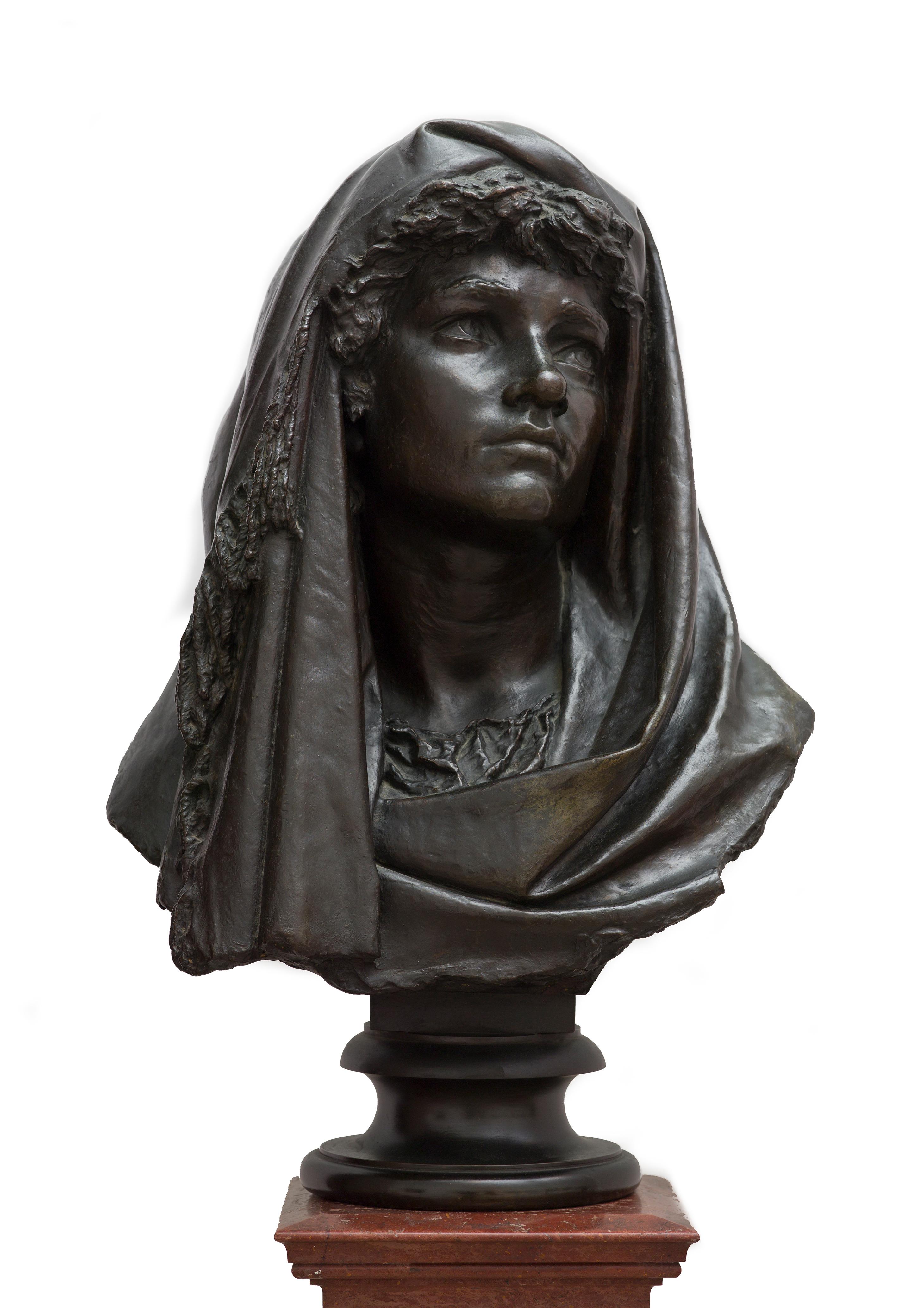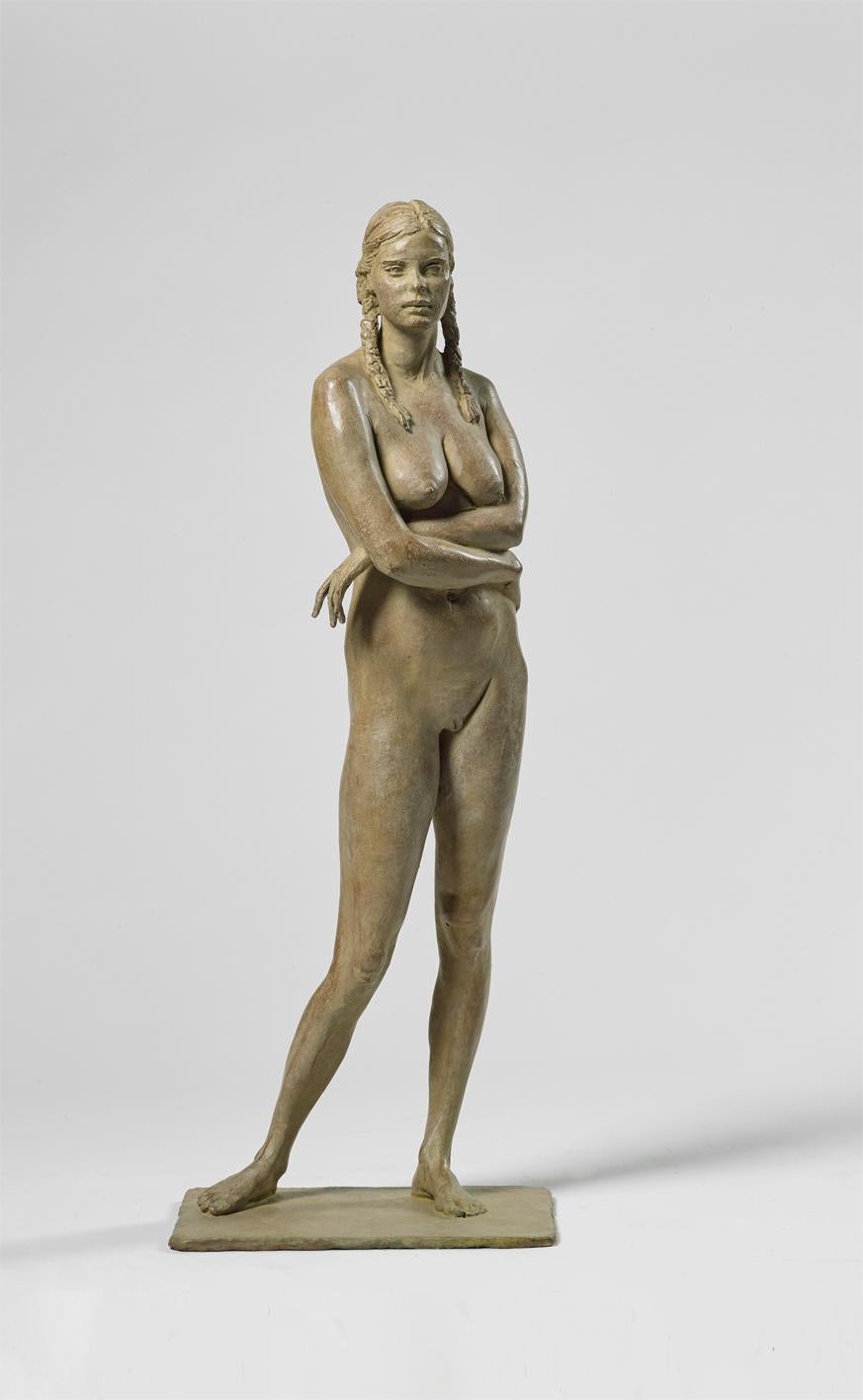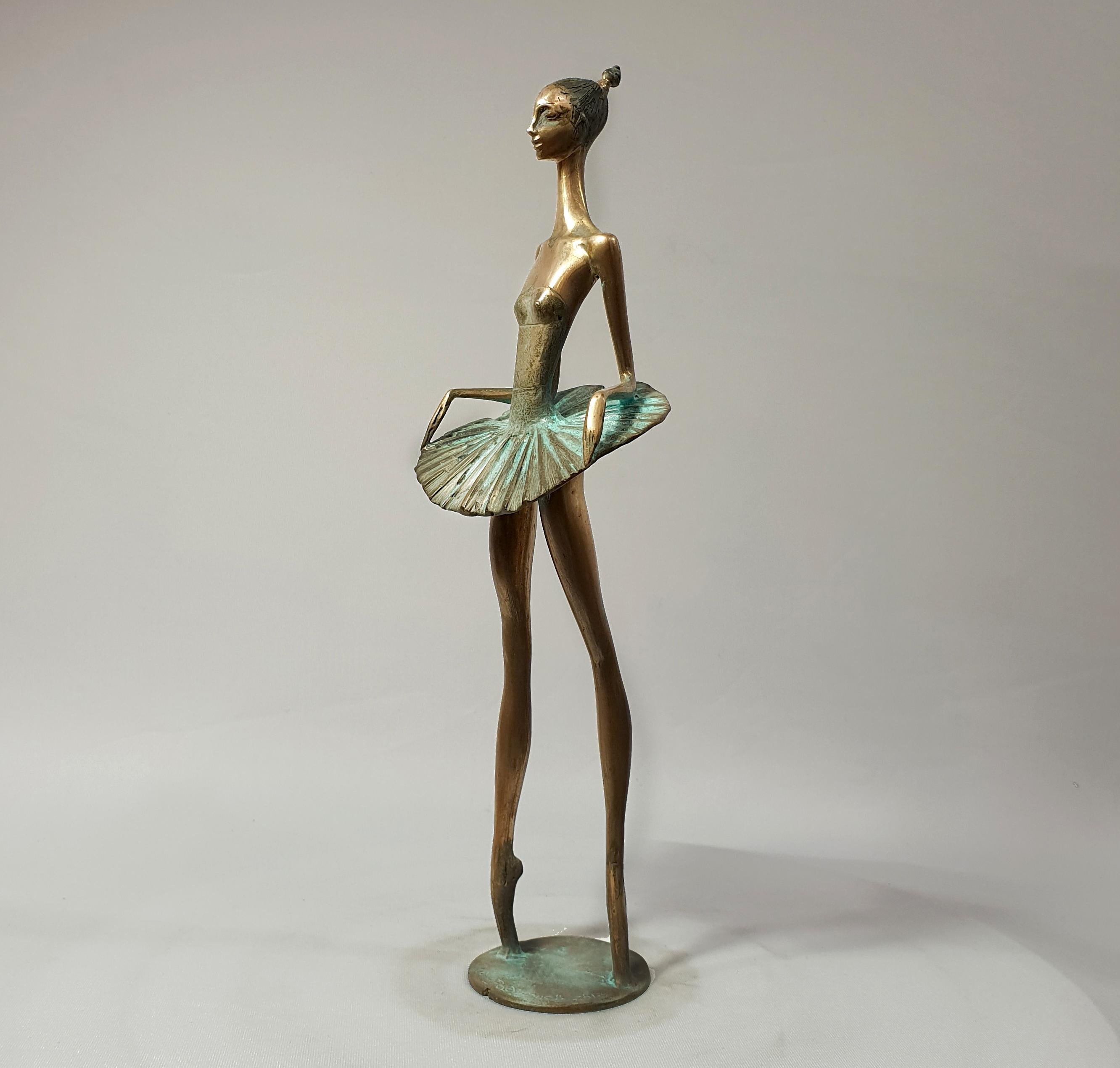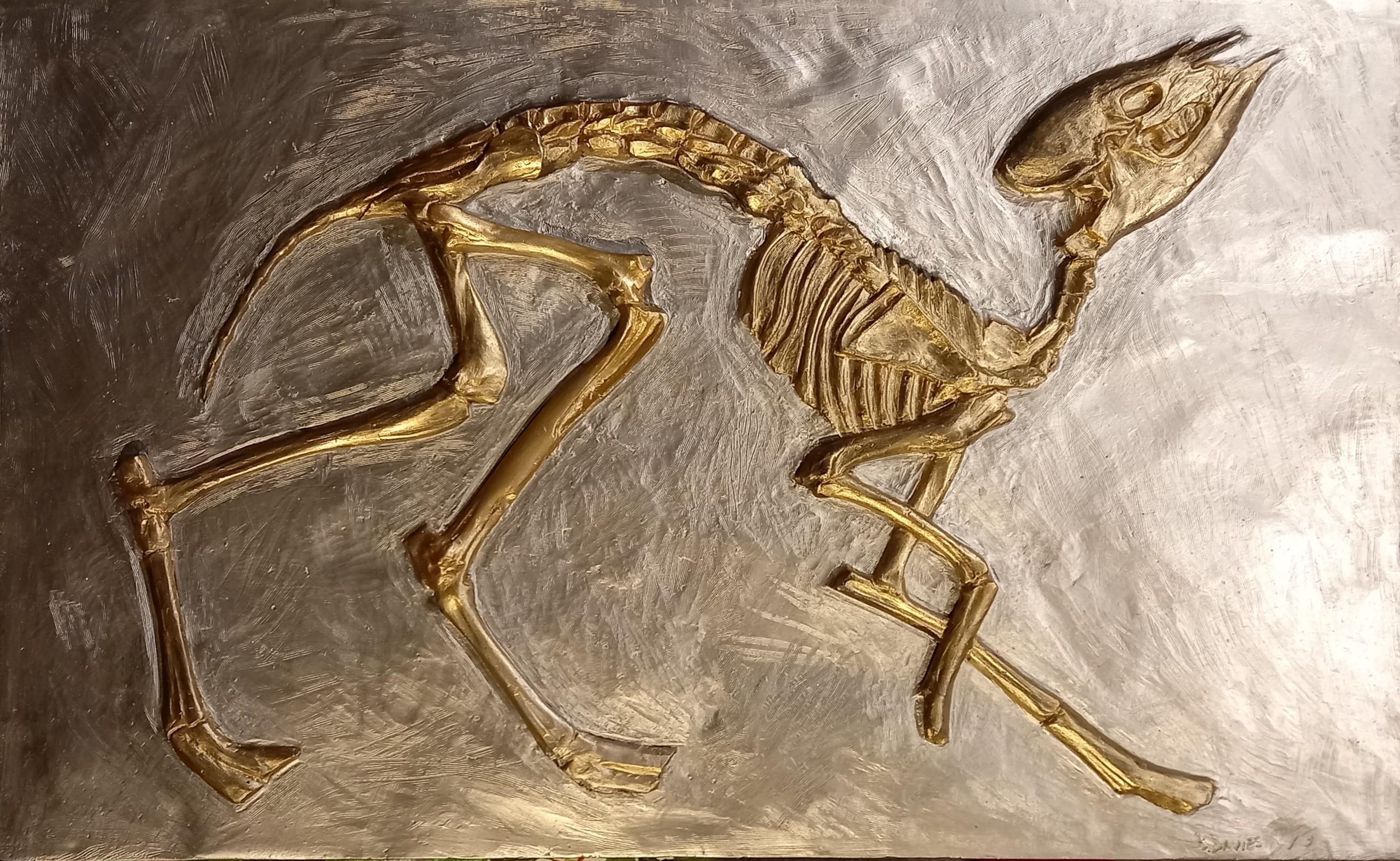Items Similar to Sir Winston Churchill Memorial By Ivor Roberts-Jones
Want more images or videos?
Request additional images or videos from the seller
1 of 11
Ivor Roberts-JonesSir Winston Churchill Memorial By Ivor Roberts-JonesCirca 1970
Circa 1970
About the Item
Ivor Roberts-Jones
1916-1996 | British
Sir Winston Churchill Memorial
Bronze
This exceptional and iconic sculpture of Sir Winston Churchill is the original maquette for the renowned Churchill statue in Parliament Square by Ivor Roberts-Jones. Depicting Churchill in his garter robes, this sculpture is completely unique and depicts one of history's most revered leaders.
Sir Winston Churchill's unwavering resolve and exceptional leadership left an undeniable and enduring legacy. Upon his passing, a sculpture was commissioned to be unveiled in 1971 at the prominent Parliament Square in London. The Winston Churchill Statue Committee orchestrated an artistic search to honor the Prime Minister’s indomitable leadership with a fitting tribute. The winner of the highly competitive committee’s design competition in 1969 was Ivor Roberts-Jones, a distinguished graduate of the renowned Royal Academy of Arts.
For this important statue, Roberts-Jones chose to depict Churchill wearing his Order of the Garter robes — his velvet mantle, a hat and ceremonial elements — to appropriately symbolize the great leader's immense honor and dignity. The Order of the Garter is the oldest and most prestigious order of chivalry in Britain, founded in 1348 by King Edward III. Membership is granted exclusively to those who have served the nation exceptionally, as exemplified by Winston Churchill's significant leadership during World War II. Upon viewing Robert-Jone’s sculpture, the Royal Fine Arts Commission made a few tweaks and then unanimously approved his design.
After receiving a wish from Lady Clementine to depict her husband in military attire, Roberts-Jones began his revision, and the original maquette bronze, this very statue, was gifted to Sir John Tiney, the chairman of the Winston Churchill Statue Committee. Eventually, the public was presented with the statue of Churchill, which has become the second most recognizable public statue in the United Kingdom after Nelson’s column in Trafalgar Square. This maquette was the only example ever made that showcases the original winning design approved by the Royal Fine Arts Commission, and was featured on The Finest Hour’s 1996 cover. It was loved and safeguarded by Tiney until his passing. Tiney’s wife later bestowed her late husband’s prized statue to the International Churchill Committee chairman, also the future husband of one of Churchill’s great-granddaughters. We have acquired this masterpiece directly from them.
The statue was paid for with donations. Donors to create it included Queen Elizabeth, the Queen Mother, Prince Phillip, the Duke and Duchess of Gloucester and the Baroness Spencer-Churchill. It comes with its unique handwritten vellum book.
Circa 1970
Statue: 36" high x 23" wide x 12 3/8" deep
On base: 67" high
Provenance: Private collection of Sir John Tiney
Private collection, United Kingdom
- Creator:Ivor Roberts-Jones (1913 - 1996, British)
- Creation Year:Circa 1970
- Dimensions:Height: 36 in (91.44 cm)Width: 23 in (58.42 cm)Depth: 12.38 in (31.45 cm)
- Medium:
- Movement & Style:
- Period:
- Condition:
- Gallery Location:New Orleans, LA
- Reference Number:
About the Seller
5.0
Vetted Seller
These experienced sellers undergo a comprehensive evaluation by our team of in-house experts.
Established in 1912
1stDibs seller since 2013
15 sales on 1stDibs
Typical response time: 4 hours
- ShippingRetrieving quote...Ships From: New Orleans, LA
- Return PolicyThis item cannot be returned.
More From This SellerView All
- CoupleBy Agustín CárdenasLocated in New Orleans, LAInfused with a crisp modernity and subtle sensuality, this bronze sculpture by Cuban-born artist Agustin Cárdenas is an exceptional example of late-2...Category
20th Century Modern Figurative Sculptures
MaterialsMarble, Bronze
- Girardon’s Equestrian Portrait of Louis XIVLocated in New Orleans, LAKing Louis XIV, one of France's greatest monarchs, sits confidently astride a prancing steed in this bronze equestrian statue. The extraordinary work is a reduction of the portrait of the Sun King by François Girardon, one of the most noted and influential sculptors of the period. Looking back to the great masterpieces of antiquity, Girardon took his inspiration from the seminal ancient Roman marble of Marcus Aurelius, now in the Musei Capitoline (Rome). Louis XIV is thus portrayed here as a conquering Roman hero, his costume adorned with many neoclassical motifs, hand outstretched in a gesture of command. The result is an imposing royal portrait of power and absolute authority that pays homage to one of the most important sovereigns in French history. It was in 1685, at the very height of his rule, when Louis XIV commissioned the monumental bronze of himself from the great Girardon. As sculptor to the king, Girardon was a key figure in the decoration of the gardens at the Château de Versailles, and he was later commissioned to complete several important royal...Category
19th Century Other Art Style Figurative Sculptures
MaterialsBronze
- Winston Churchill Artist Proof Bust by Ivor Roberts-JonesBy Ivor Roberts-JonesLocated in New Orleans, LAIvor Roberts-Jones 1916-1996 British Sir Winston Churchill Artist Proof Bronze with a green patina One of the greatest leaders of the modern world, Winston Churchill is among the...Category
20th Century Figurative Sculptures
MaterialsBronze
- Vénus De Milo Aux Tiroirs By Salvador DalíBy Salvador DalíLocated in New Orleans, LASalvador Dalí 1904-1989 Spanish Vénus de Milo aux tiroirs (Venus de Milo with drawers) Signed "Salvador Dalí EA III/IV" (on base) Bronze One of th...Category
20th Century Post-Impressionist Nude Sculptures
MaterialsBronze
- Arabesque on Right Side, Right Hand Close to Earth, Left Arm OutsideBy Edgar DegasLocated in New Orleans, LAOne of a series of sculpted dancers created by the incomparable Edgar Degas, this exceptional bronze exudes all of the expressivity one expects from this 20th-century great. Degas captures the essence of his model in the graceful work, as she strikes a particularly difficult pose of the arabesque. The dancer's features have been manipulated and simplified, executed in a manner that seems almost as if one of Degas' Impressionist canvases has come to life. Degas was obsessed with capturing the dancer in motion throughout his career. He rendered their grace and movement in oil, pastel, pencil, chalk and wax - in fact, of the seventy-four wax sculptures created by Degas during his lifetime, forty of them depicted dancers. Seven of these belong to his series that capture the various forms of the arabesque, and the present work is included among them. It details one of the most difficult and animated poses of the ballet. Degas’ dancer is precariously posed in a study of balance and motion, one leg gracefully thrust into the air as she tilts her body down towards the earth and extends her arm forward. The sense of her movement is perfectly captured in the extraordinary work, as well as the fluid lines of her body. The bronze is a sought-after rarity in terms of Degas’ sculptures. Not only are his dancers the most desirable of his work, but this bronze is also distinguished by the fact that it is a Valsuani bronze, meaning it faithfully records Degas’ wax version’s pose as it appeared at the time of its creation. Most Degas' bronzes that are found on the market were cast by Hébrard – these serialized bronzes are surmoulages, or “aftercasts,” that were cast from the modèle bronzes currently in the Norton Simon Museum (Pasadena). Because these bronzes are second generation, they are smaller and far less detailed that the current bronze. This example, however, was cast by Valsuani from a plaster that was taken directly from Degas’ waxes, according to scholarship by the art historian Dr. Gregory Hedberg. These plasters were created by Degas’ sculptor friend Albert Bartholomé shortly after Degas completed his wax figurines. Thus, they record the earliest versions of Degas’ wax sculptures, before they were damaged by time or handling, and before Degas himself altered the works. The Hébrard bronzes...Category
20th Century Impressionist Figurative Sculptures
MaterialsBronze
- Bronze of Pluto Abducting Proserpine after François GirardonLocated in New Orleans, LAAfter François Girardon 1628-1715 French Pluto Abducting Proserpine Bronze This High Baroque period composition captures the famed narrative of Pluto and Proserpine from Roman mythology. The late 17th-century patinated bronze, created after François Girardon's marble composition, captures the very moment that Pluto seizes Proserpine. The anguished goddess reaches skyward, attempting to escape the god’s grasp while Pluto’s stoic face betrays his knowledge that his ploy will succeed. This pivotal moment in the mythological tale has captured the imagination of many art historical greats, from Bernini to Rubens. François Girardon’s version of the climax demonstrates incredible finesse and artistry, modeled expertly in bronze in the present work by a later sculptor. The statue brings a twist of intertwined bodies into a dynamic frenzy, paralleling the tension of the legendary story. In ancient Roman mythology, Proserpine, the beautiful daughter of Ceres — known as Persephone in Greek mythology — was picking flowers in the fields when she was suddenly abducted by Pluto, the god of the underworld, and taken to his kingdom. Consumed with grief, her mother Ceres, the goddess of agriculture, scorches the earth, stopping the growth of grain and fruit. Jupiter attempts to intervene and secure Proserpine’s return to earth, negotiating a compromise with Pluto and the Fates that allows Proserpine to be released for part of the year before returning to Pluto’s underworld. Proserpine’s journey back and forth is an allegory for the changing seasons; when Prosperine is with her mother, the earth warms and provides bountiful harvests. Upon her annual return to the underworld, however, the earth once again becomes cold and barren. After returning to France after years of training in Rome, François Girardon quickly rose to become one of the greatest artists in France. He was elected a member of the Académie Royale de Peinture et de Sculpture in 1657 and would become Chancellor of the Royal Academy in 1695. The artist was approached frequently for royal commissions and Girardon’s Pluto was originally commissioned by Louis XIV for the gardens at his Palace of Versailles. It was one of four monumental marble groups intended to decorate the corners of Charles Le Brun’s never completed garden at the chateau, the Parterre d’Eau. Each group of three figures symbolized one of the four elements: earth, air, fire and water. Pluto’s association with hell made him the apt...Category
Early 18th Century Baroque Figurative Sculptures
MaterialsBronze
You May Also Like
- Statue of Athlete: Large Academic Style Bronze Figurative Sculpture of Nude MaleBy Mark BeardLocated in Hudson, NYmodern figurative bronze sculpture of a nude athlete 8.5 feet tall and measures 36 inches at the widest point bottom base measures ...Category
Early 2000s Academic Figurative Sculptures
MaterialsBronze
- Bust of veiled womanLocated in Roma, RMGiulio Tadolini ( Rome 1849 - 1918 ) ( attr. to ), Bust of veiled woman Bronze 61 x 37 x 22 cm.Category
Late 19th Century Academic Figurative Sculptures
MaterialsBronze
- IlaBy Giuseppe BergomiLocated in Milano, MIGiuseppe Bergomi was born in Brescia in 1953. After attending the Brera Academy of Fine Arts, he held his first solo exhibition as a painter in his ho...Category
2010s Academic Figurative Sculptures
MaterialsBronze
- Standing ballerinaLocated in Zofingen, AGSculpture from the Ballet series. The series is dedicated to classical ballet and includes over 30 sculptur...Category
Early 2000s Academic Figurative Sculptures
MaterialsMetal, Bronze
- Herbivore fossilLocated in Oswestry, GBThis shallow relief sculpture is of a 135 million years old fossil of a unknown herbivore discovered in India from the jurassic period. Davies chose this fossil amongst a plethora of...Category
20th Century Academic Figurative Sculptures
MaterialsBronze
- “Enlevement des Sabines”By Marius Jean Antonin MerciéLocated in Southampton, NYHere for your consideration is a beautiful highly detailed bronze done in the forth quarter of the nineteen century after the work of Jean Boulogne, known as Giambologna. Boulogne’s sculpture was done in marble and was completed between 1579 and 1583. The sculptor of this bronze is Antonin Mercie, a well known French sculptor born in 1845. The bronze represents the Rape of the Sabine Women (Latin: Sabinae raptae), also known as the Abduction of the Sabine Women or the Kidnapping of the Sabine Women, was an incident in Roman mythology in which the men of Rome committed a mass abduction of young women from the other cities in the region. It has been a frequent subject of artists and sculptors, particularly during the Renaissance and post-Renaissance eras. Signed on base “Mercie” for Antonin Mercie.. In very good condition wirh original brown patina. The base which depicts rocks is bronze and has been painted a matt black. Provenance:: A Sarasota estate. Mercié, (Marius Jean Antonin Mercie...Category
1880s Academic Figurative Sculptures
MaterialsBronze





